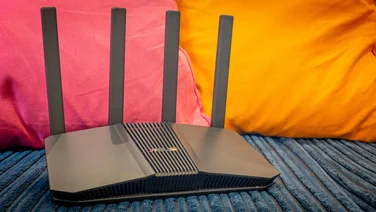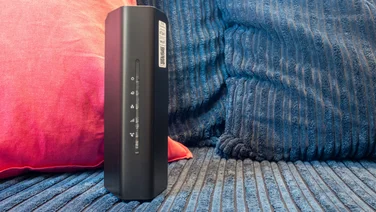To help us provide you with free impartial advice, we may earn a commission if you buy through links on our site. Learn more














- Pause Wi-Fi button on app
- Good range, great speed
- Easy to set up
- Limited physical connectivity
After years of living in the shadows, suffering the merciless bullying of disgruntled internet users, the humble wireless router is at last fighting back and BT’s Whole Home Wi-Fi is in the vanguard. It’s part of a new wave of multi-box wireless “mesh” systems that are aiming to forever banish dead spots and blanket your home with strong, solid Wi-Fi.
The concept is a pretty simple one. By spreading the wireless signal around the home using not a single router, but many, you get a strong signal everywhere. And because these systems are built with ease of use in mind by one manufacturer, they’re typically simple to set up and maintain.
While it’s certainly possible (and much cheaper) to use wireless repeaters to extend the reach of your network, the improved range they offer typically comes at the expense of simplicity of setup and performance.
READ NEXT: BT Mini Whole Home Wi-Fi review
BT Whole Home Wi-Fi review: What you need to know
BT’s system is among the most simple and effective way of achieving mesh Wi-Fi at home. It comes as a pack of two or three discs and is designed as a retrofit option you can attach to an existing router of any make or model.
Each of the discs has an Ethernet port on the rear so you can attach non-wireless network devices and, although features are relatively basic, the setup, performance and ease of use of this system make it a viable choice.
BT now makes a system where the mesh Wi-Fi is built into the main router but that’s only available to subscribers to BT Plus, making it somewhat expensive. And although the BT Whole Home Wi-Fi system has been out for a few years now, it remains a great value option that works effectively.
BT Whole Home Wi-Fi review: Price and competition
The mesh wireless market has exploded since the BT Whole Home Wi-Fi first appeared on the scene. But despite its relative age, BT’s steady price cuts have ensured the original product has remained relevant.
And with BT building the system into its next-generation router – the BT Smart Hub 2 – it won’t be long before BT’s Whole Home Wi-Fi becomes even more popular.
The original system is around £170 for a triple pack, which is still good value for the specification and compares very favourably with £230 for the Linksys Velop system, around £313 for the super-speedy Zyxel Multy X – both mesh wireless systems that come with three nodes. If you want to save even more money, and don’t mind sacrificing a little performance, consider the Tenda MW6 instead. This is a solid mesh system that also comes with three nodes and a claimed coverage of 560m2 but costs a mere £127 on Amazon.
Alternative picks: |
||
| Linksys Velop | £230 | Buy now from Amazon |
| Zyxel Multy X | £313 | Buy now from Amazon |
| Tenda MW6 | £127 | Buy now from Amazon |
BT Whole Home Wi-Fi review: Setup and features
BT’s system works a very similar way to Google Wifi and other mesh systems that have appeared over the past year or so and, just like those systems, Whole Home Wi-Fi is designed to be completely plug-and-play. Download the app, run through step-by-step instructions, and you’ll be up and running in minutes.
It’s a very simple process: you connect the first disc-shaped wireless unit via from its single Gigabit Ethernet port to your existing wireless router. Once this automatically configures itself, you’re ready to plug your second and third discs in, which automatically pair up with the first and establish a simple “mesh” network.














You can place the discs wherever you like, but to get the best coverage and the strongest speeds, the app monitors signal strength and lets you know if you could do better by positioning the second and third satellite discs closer to the hub.
Once you’ve done this, you’ve pretty much finished with the setup. There’s nothing else to do other than pluck the plastic tab from the rear of one of the router discs, and enter the preconfigured security key into all your devices.
Although BT Whole Home Wi-Fi offers dual-band connectivity – each disc is effectively a 4×4 MIMO 802.11ac router offering speeds of up to 1,733Mbits/sec over 5GHz and 800Mbits/sec over 2.4GHz – it doesn’t surface two separate networks in the way a normal wireless router would.
Instead, the system uses a technique known as band-steering to assess each connected device and hook it up to the most appropriate frequency band and to the disc offering the strongest connection. It’s a system that does genuinely seem to work.














The one misstep here is that the BT Whole Home Wi-Fi system insists on creating its own separate wireless network from your original wireless router’s; if you don’t want your devices automatically connecting to your old, inferior network, you’ll either have to disable wireless on that router or go around deleting the old network from all your devices. That’s not ideal.
Still, if that’s the only inconvenience, I’m willing to put up with it. The app itself is very easy to use and get to grips with and I particularly like the “pause” button, which allows you to temporarily shut down Wi-Fi household-wide. A handy tool for parents who find it a challenge to get their children to put down their devices and actually take part in conversation.
BT Whole Home Wi-Fi review: Performance
What’s most impressive is that performance is stellar across the board. I tested it at home, where my usual setup is a Sky Q wireless mesh network and it blew it away in terms of both range and throughput speed.
My broadband connection comes in on the first floor at the front of the house, and this is where I carried out my first, close-range test. Using an Apple MacBook Pro 15 equipped with a 3×3 stream Broadcom Wi-Fi adapter as the test client, I saw average throughput of 89MB/sec to (yes, that’s megabytes, not megabits).














Next, I moved down one flight of stairs and into the kitchen at the rear of the house. Note that, when setting up the system, I tried to replicate as closely as possible the positions of the various Sky Q access points and booster boxes in my original network. I only tweaked the positions slightly on the advice of the BT Whole Home Wi-Fi app.
Now, I would normally see throughput speeds of around 8MB/sec on the Sky Q network in the kitchen, but the BT Whole Home Wi-Fi system flew past it with an average throughput of 36MB/sec. That’s easily strong enough to stream 4K Netflix via a Chromecast Ultra, and it’s double the speed the BT Smart Hub was able to muster in that position.



Moving to a second-floor bedroom immediately above the primary Whole Home disc revealed even more impressive results. Here I saw an average of 67MB/sec throughput. The slowest throughput speeds I saw were in the study at the rear of the house (25MB/sec) and the living room at the front of the house, immediately below the primary Whole Home Wi-Fi disc (22MB/sec).
Your numbers will be different from mine, of course – every household is different – but what’s promising about the performance of the BT system is that even in the trickiest of spots I was getting a strong signal and decent throughput. That can only be a good thing.
BT Whole Home Wi-Fi review: Verdict
Overall, BT’s Whole Home Wi-Fi is a great product but what’s even more impressive is that it remains relevant, despite its age. That’s mainly due to the price, which has been steadily cut since it first appeared. It’s now one of the cheapest setups around with a triple pack costing under £200, where Google Wifi, for example, is £300.
Coupled with great performance and easy setup, that makes the BT Whole Home Wi-Fi an excellent way to extend the range of an ageing router that may be struggling to provide coverage across your home.








